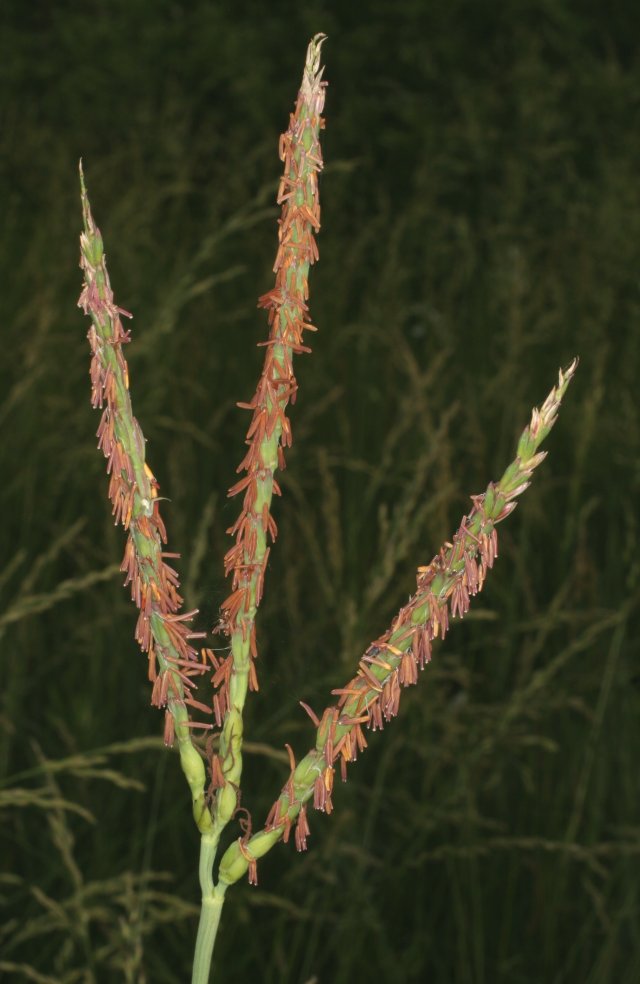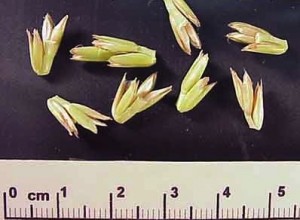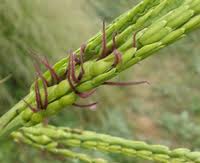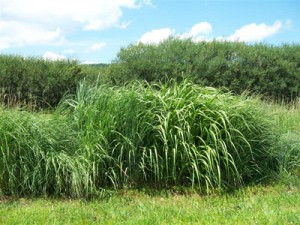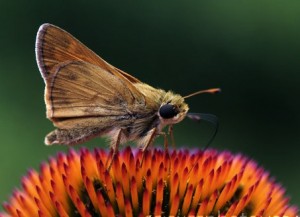At grass conferences I have been told more than once that there are no toxic native North American grasses (the problem are the imports.) Eastern Gamagrass (Tripsacum dactyloides) delightfully falls into the native description. And at 27% protein it’s one of the more nutritious native grasses if not the most nutritious.
Among its many names are Bullgrass, Eastern Mock Gama, Fakahatchee Grass, Gamagrass, Herbe Grama, Maicilo Oriental, Pasto Guatemala, Wild Corn, Zacate Maicero and Queen of the Grasses. Eastern Gamagrass is conspicoulsly absent from Native American Food Plants by Daniel Moerman. However, most of our ethnobotanical information on Native American foods is from western Indians and this is an eastern species. We certainly know the buffalo liked it as do cattlemen. They call it Ice Cream Grass because the cattle like it so much. In fact over grazing by ranchers led to its replacement by other grasses and grains. (As a clump grass it needs to regenerate if grazed closely.)
From our point of view the edible part is a tough yellow grain. Whether it can be used for flour depends upon availability. Left unmilled the grains will pop like Strawberry Popcorn. They can also be cooked whole like wheatberries or made into a gruel.
The species can be found east of the Rocky Mountain states excluding northern New England. It is also native to Central and South America and the Caribbean. The large clumps of grass can live to be 50-years old or more. Growing to eight or nine feet tall the leaf blades are flat and long, 12 to 30 inches and up to more than an inch wide. Leaves have a well-defined mid-rib near the stalk. Flower spikes are six to 10 inches long and are made up of several spikes, often three. Similar to corn it has separate male and female flowers but unlike corn each spike has both male and female flowers. Male flower are found on the top three-quarters of the spike and female flowers on the bottom fourth. (Look for gold rice-like bits on top of the spike, and red-brown thread on the bottom quarter.) Technically it is male flowers on top with extruded anthers and cupulate fruit-cases on the bottom. One issue with the grass, however, is chill hours needed to germinate. Moist seed kept in cold storage for six to eight weeks germinate better than non-chilled seeds. There are two commercial cultivars, “Pete” and “Iuka IV.” Commercially a pound of seed costs about $20 if you order only one pound, around $17.50 per pound if you order a lot. There are 5,000 to 7,000 seeds per pound.
Flower spikes ripen from the top down. Seeds are produced from June to September. Yield is not high so it is a grain added to other mixtures unless one can find enough to make flour out of it. Efforts are underway to cross breed the plant to produce more grain but that will likely result in a hybrid with less protein content.
There is no agreement on what Tripsacum means. Many copied Internet sources say it means “polished” from the Greek verb Trivo, to polish or show signs of wear (the stem is smooth.) Frankly I think that is nonsense. I have a hard time getting triP… out of triV… Not close even considering the Dead latin influence. More so the usual botanical Greek term for polished is “gano” as in Ganoderma (polished leather.) Here’s a different view: The grains are tough. “Tripsis” in Greek — with a P not a V — means durable, tough. And “psakas” means grain or a small piece broken off. Put those together and bastardize them through Dead Latin and I can see easily Tripsacum. So I am going to say Tripsacum (TRIP-suh-kum) means “tough grain.” Dactyloides (dack-ta-LEED-deez) means finger-like, referring to the flower spikes…. ghoulish long skinny fingers…
Deer like the seed as well and the plant is the larval food of choice for the Bunchgrass Skipper butterfly. There is also a native Florida Gamagrass but it is confined to the southern part of the state, is much smaller, skinnier and endangered.
Green Deane ITEMIZED Plant Profile: Eastern Gamagrass
IDENTIFICATION: Tripsacum dactyloides, fountain-like clumps to nine feet tall, 4 feet wide. The leaves erect up to 2.5 ft long and an inch wide. Stems can reach six-feet long. Distinctive flowers spikes rise above the leaves on slender stems. Spikes have many tightly fused spikelets that take on the appearance of being ‘jointed’. When in flower the spikes appear to have golden grains of rice hanging from them. Leaves lack auricles but have a ligule that is a fringe of hairs. Rootstock is usually wider than the plant one reason for its use in land reclamation.
TIME OF YEAR: Flowers in late spring to mid-summer, seeds in late summer to fall. Frost colors the leaves red and bronze.
ENVIRONMENT: Moist areas around lakes, streams, swamps, ditches et cetera, full sun, fertile soil. Evergreen in frost-free areas.
METHOD OF PREPARATION: Winnowed seeds can be used like wheat. Seed will pop like corn.

